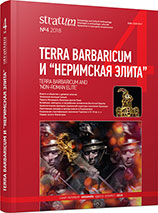Импорт товаров в амфорах и краснолаковой керамики на Боспор в конце IV — первой половине VII вв.
Import of Goods in Amphorae and Red Slip Ware into Bosporus in the Late 4th — First Half of the 7th Centuries
Author(s): Anna V. SmokotinaSubject(s): History, Archaeology, Economic history, Ancient World, Middle Ages, 6th to 12th Centuries
Published by: Издательский дом Stratum, Университет «Высшая антропологическая школа»
Keywords: Bosporus; Late Roman period; Early Byzantine period; trade; amphorae; red slip ware
Summary/Abstract: The amphorae and red slip ware are an important source for studying social and ethnic structure of the society and the socio-economic history of Bosporus in general. From the late 4th and until the beginning of the 6th century, the Black Sea regional trade played an important role, and Bosporus had closest relations with the South Pontic centers. The Local Bosporan amphorae prevailed in the complexes of the late 4th — the early 6th centuries in Bosporus and Tyritake, while Sinopean and Heraclean imports were also well represented. The import of goods in amphorae from the Eastern Mediterranean centers increased sharply after the transition of Bosporus under control of the Byzantine Empire at the beginning of the second quarter of the 6th century. During this period, the LRC/PhRS vessels in Bosporan complex reached approximately 70 %, on average, of all the red slip ware. By the late 6th century, the Phocean import had dramatically declined. Bosporan complexes of the first half of the 7th century have not been found yet. Nevertheless, the imported finds of this period (forms ARS 105B/C and 109A, LRC/PhRS 10C) suggest some further continuation of traditional trade and economic relations of the city and delivery of goods from the Mediterranean centers.
Journal: Stratum plus. Археология и культурная антропология
- Issue Year: 2018
- Issue No: 4
- Page Range: 263-279
- Page Count: 17
- Language: Russian
- Content File-PDF

